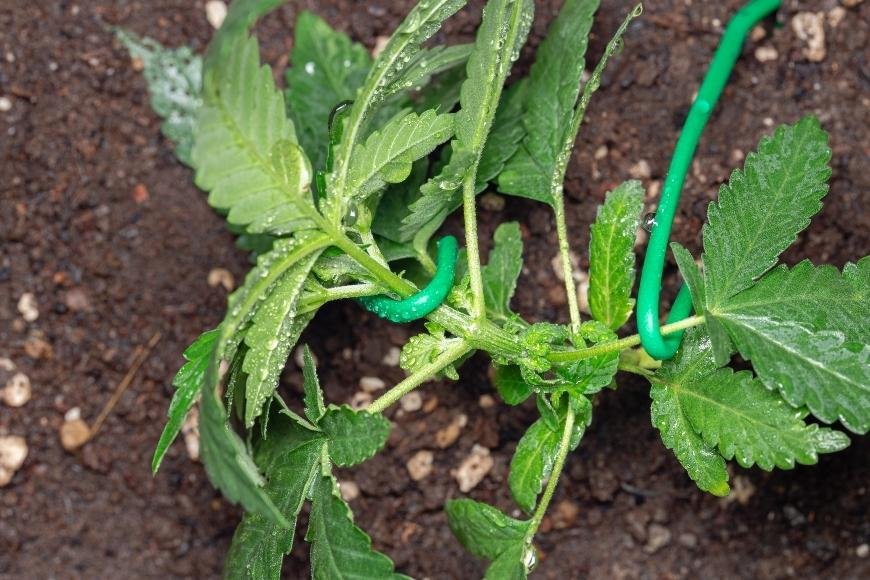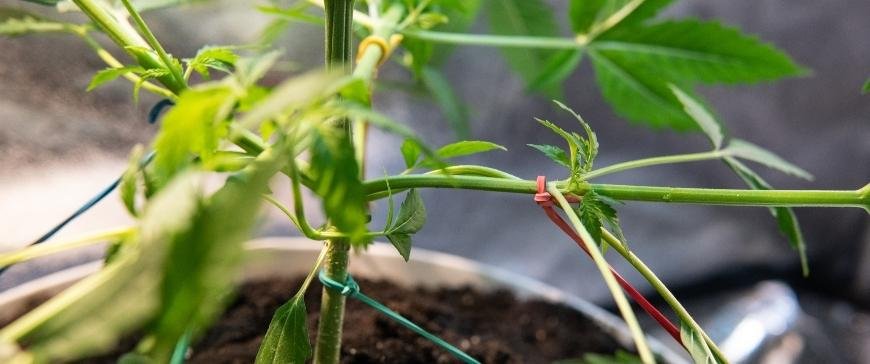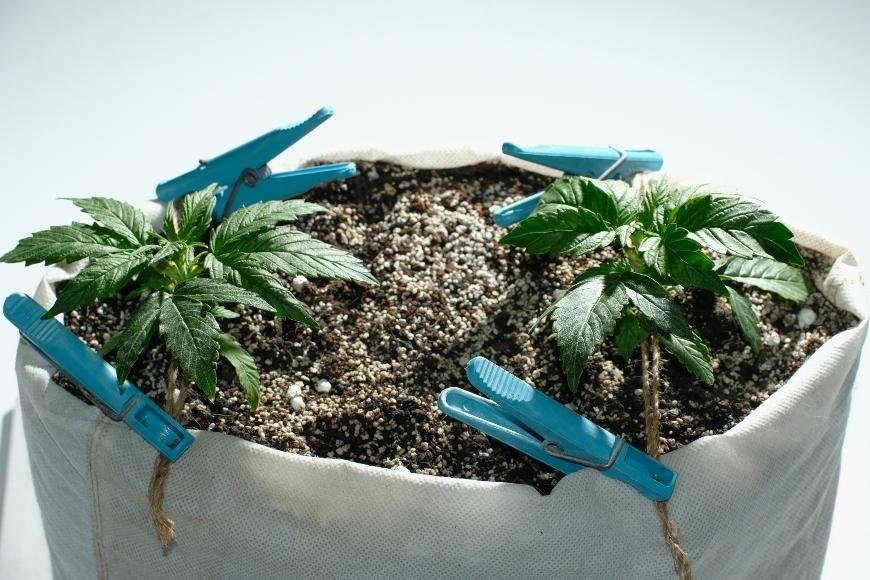How to Low Stress Train Cannabis Plants
Discover how to low stress train cannabis plants for maximum yields with our step-by-step guide, covering techniques and tips to improve your growing success.

If you're looking to learn how to low stress train cannabis plants, you've come to the right place. Low Stress Training (LST) is a growing technique that involves gently manipulating the growth of your weed plants in order to improve yields and create an even canopy for better light distribution.
In this guide, we'll look at the advantages of LST over high-stress techniques and provide a step-by-step approach to low stress training for cannabis plants, as well as offering tips on successful implementation and troubleshooting common issues. We'll also share tips for successful LST implementation and discuss when it's time to stop lst training.
Furthermore, we will help troubleshoot common issues encountered during low stress training so that you can confidently grow healthy and potent cannabis plants with ease. So get ready, because by the end of this post, you'll be well-equipped with all the knowledge needed on how to low stress train cannabis plants like a pro!
Table of Contents:
- What is Low Stress Training?
- The Science Behind Low Stress Training
- Benefits of Low Stress Training
- How to Low Stress Train Cannabis Plants
- Tips for Successful Low Stress Training
- When to Stop Low Stress Training
- Troubleshooting Common Issues with Low Stress Training
- Frequently Asked Questions How to Low Stress Train Cannabis Plants
- Conclusion
What is Low Stress Training?
Low Stress Training (LST) is a popular technique among cannabis growers that involves manipulating the growth of cannabis plants by bending and tying down their main stem and branches. The goal of LST is to create a flat, wide canopy of buds, which can lead to increased yields and more efficient use of grow space. This method allows for better light penetration throughout the plant's foliage, ensuring all parts receive adequate exposure.
LST has its roots in ancient gardening practices where farmers would train fruit trees and grapevines into specific shapes for optimal growth. Today, this technique has been adapted by cannabis cultivators who recognize its numerous benefits when applied correctly.
This method stands out from other training techniques like High-Stress Training (HST), as it aims to minimize stress on the plants while still achieving desired results. By avoiding excessive stress or damage during training, LST helps maintain healthy plants that are less susceptible to diseases or pests.
The Science Behind Low Stress Training
- Hormonal Balance: When you bend your plant's stems using LST methods, you're affecting its hormonal balance - specifically auxins - which control cell elongation and apical dominance. By disrupting this balance through manipulation, you encourage lateral branching instead of vertical growth.
- Better Light Penetration: A flat canopy ensures even distribution of light across all leaves rather than concentrating only on top colas if left untrained (canopy management). This leads to healthier overall development with higher bud production potential.
- Air Circulation: Properly trained plants allow air to flow more freely around the branches, reducing humidity and preventing mold or mildew from forming.
By understanding the science behind LST, you can better appreciate its benefits and implement this technique effectively in your cannabis garden. To maximize the advantages of LST, this article will provide detailed instructions on how to properly execute it.
Low Stress Training is an ideal approach to optimize your cannabis plants' output, potentially conserving time and funds in the long haul. With that said, let's take a look at some of the benefits of Low Stress Training for your cannabis plants.
Benefits of Low Stress Training
Low Stress Training (LST) offers a variety of benefits for cannabis growers, especially those with limited space or looking to maximize their yields. Some key advantages include:
- Increased Yields: By creating a flat canopy and exposing more bud sites to direct light, LST can significantly increase the overall yield of your cannabis plants. This technique allows each branch to receive an equal amount of light, resulting in even growth and larger harvests.
- Better Light Penetration: In traditional growing methods, taller branches may block lower ones from receiving adequate sunlight. With LST, all branches are evenly exposed to light sources such as LED grow lights or natural sunlight. This ensures that every part of the plant gets enough energy for optimal growth.
- Easier Maintenance: A well-organized LST setup makes it easier for growers to access individual branches when pruning or harvesting buds. Additionally, it helps prevent overcrowding and tangled stems by maintaining an organized structure throughout the plant's life cycle.
- Ideal for Limited Space Growers: For those working with limited space like indoor gardens or small outdoor areas, LST is perfect because it encourages horizontal growth rather than vertical stretching which can quickly consume valuable room in tight spaces.
- Fewer Risks Compared To High-Stress Techniques: LST techniques do not involve cutting any parts off your plant; instead they gently manipulate its shape through bending and tying down stems which reduces stress on the plants compared to high-stress training methods like topping or fimming where you cut off parts of the main stem/branches.
Low Stress Training can provide many benefits to cannabis growers, such as increased yields and improved plant health. With the right preparation and knowledge, you can successfully reap these rewards. Now let's explore how to prepare for Low Stress Training.

Preparing for Low Stress Training
Before you dive into the world of Low Stress Training, it's essential to ensure your cannabis plants are in optimal condition. Healthy plants in the vegetative stage of growth will respond better to LST and have a higher chance of success. Here are some key factors to consider before starting:
- Plant Health: Make sure your cannabis plants are healthy and free from any diseases or pests. A strong plant will be more resilient during LST.
- Veg Stage: It is crucial that your plants are in the vegetative stage when performing LST since this is when they're actively growing new branches and leaves. Attempting LST during flowering can cause stress on the plant, leading to reduced yields.
- Growth Medium: Ensure that your chosen growth medium (soil, coco coir, hydroponics) provides adequate nutrients and support for proper root development. This will help maintain overall plant health throughout the training process.
- Ideal Environment Conditions: Maintain ideal temperature, humidity levels, lighting conditions, and airflow within your grow space as these factors play a significant role in promoting healthy growth during LST.
In addition to these basic requirements, having some essential tools at hand can make Low Stress Training easier and more effective. These include soft ties or clips (Velcro Plant Ties, twist ties), gardening gloves (to protect both you and your plants), pruning shears (for trimming excess foliage if needed), stakes or supports (if necessary).
Once your plants have been inspected and deemed prepared for Low Stress Training, you can then proceed to the actual training. Remember that patience is key - take your time when bending and securing branches to avoid causing unnecessary stress or damage.
Preparing for Low Stress Training is an important step in ensuring that your cannabis plants are healthy and productive. Now, let's explore the process of how to low stress train these same plants.
How to Low Stress Train Cannabis Plants
To ensure the best results, follow these steps:
- Select the right time for LST: It's crucial to begin LST when your cannabis plants are in their vegetative stage, as this is when they are most flexible and responsive to manipulation.
- Gently bend the main stem and branches: Using your fingers or a soft object like a pencil, gently bend the main stem and branches until they are horizontal or slightly angled downwards. Be careful not to over-bend or break them, as this can damage your plant and reduce yields.
- Tie down bent stems and branches: Once you have achieved the desired angle, secure each bent stem or branch with ties or clips so they remain in place. You can use materials such as gardening wire, string, rubber bands or even pipe cleaners for this purpose. Make sure not to tie too tightly; allow some room for growth while still maintaining tension on the bent parts of your plant.
- Maintain an even canopy height: As new shoots grow taller than others due to apical dominance suppression from LST techniques applied earlier in their development process., make sure all tops stay at roughly same level by bending any outliers back towards center point where necessary - keeping everything uniform helps maximize light exposure efficiency across entire surface area.
It's important to remember that LST is an ongoing process throughout the vegetative stage of your cannabis plants. Regularly check on your plants and adjust ties as needed, ensuring no new shoots have grown too tall or become tangled in other branches.
Tips for Successful Low Stress Training
For successful low stress training, it is essential to bend the main stem and branches in order to achieve an even canopy without overdoing it. Adhering to these suggestions can help you cultivate flourishing, bountiful cannabis plants with a uniform canopy.
- Avoid over-bending or breaking stems: While it's important to bend the main stem and branches in order to create a flat canopy, take care not to overdo it. Over-bending or breaking stems can damage the plant and reduce yields. Be gentle when manipulating your plants; if you feel resistance while bending a branch, ease up slightly.
- Use soft ties or clips: When securing bent branches in place, use soft ties or plastic clips designed specifically for plant training. These will hold the branches securely without causing damage due to their flexible nature.
- Maintain consistent light exposure: Ensuring all parts of the plant receive adequate light is crucial during LST. Rotate your pots regularly so each side gets equal exposure and consider using supplemental lighting like LED grow lights if necessary. Check out our guide on choosing the right grow lights.
- Check on plants regularly: It's essential to monitor your cannabis plants frequently during LST as new shoots may grow too tall or become tangled in other branches. Adjust ties as needed and remove any unnecessary foliage that might block light from reaching lower growth sites.
- Patiently adjust throughout vegetative growth: LST is not a one-time process; you'll need to continue adjusting your plants throughout the vegetative stage. As new branches grow, bend and secure them in place so they maintain the desired flat canopy shape.
By following these tips for successful low stress training, you can ensure your cannabis plants will grow healthy and strong. Once you've achieved your desired results, it's time to cease low stress training so as not to exceed the limits.
When to Stop Low Stress Training
Once your cannabis plants have progressed in their growth and development, it is important to determine when you should discontinue the Low Stress Training (LST) technique. Once buds start forming on your plants, you should cease LST as further manipulation may damage these delicate structures.
Signs That It's Time to Stop LST
- Bud formation: When you notice small bud sites developing along the branches of your plant, this is a clear indication that it's time to stop applying LST techniques.
- Late flowering stage: As your cannabis plants enter the late flowering stage, their focus shifts towards producing potent and resinous buds. At this point in their life cycle, any additional stress from training can negatively impact bud development and overall yield.
- Inability to bend stems without breaking: If you find that the stems have become too rigid or brittle for bending without snapping them, then it's best not to risk damaging your plant by continuing with LST.
To ensure optimal growth during the final stages of development, consider providing additional support for heavy branches laden with buds. You can use trellis nets or bamboo stakes as supportive structures around your cannabis plants. This will help prevent branches from drooping under their own weight while also allowing ample airflow throughout the canopy. Remember always monitor temperature levels and humidity within your grow space during this crucial period.
Maximizing yields with low stress training is possible, yet recognizing when to cease is key. Troubleshooting common issues with low stress training can help you ensure that your plants are getting the best possible care and results.

Troubleshooting Common Issues with Low Stress Training
While Low Stress Training (LST) is an effective method for increasing cannabis yields and promoting even growth, it's not without its challenges. Identifying and resolving common issues associated with Low Stress Training can be difficult, but this article will provide helpful solutions.
Stressed Plants
If your plants become stressed during LST, there are several steps you can take to alleviate the issue:
- Provide additional light: Ensuring your plants receive adequate light is crucial for their overall health. If they're showing signs of stress, consider adding more lights or adjusting the placement of existing ones. You can learn more about optimizing lighting conditions in our guide on cannabis lighting techniques.
- Nutrient adjustments: Stressed plants may benefit from a boost in nutrients. Be sure to follow recommended dosages and schedules for your specific strain and growing medium. Check out our article on nutrients for cannabis growth for further guidance.
- Temperature control: Cannabis plants thrive within a certain temperature range - typically between 20-30°C (68-86°F). Ensure your grow space maintains these optimal temperatures by using heaters or air conditioners as needed. Learn more about maintaining ideal temperatures in our post on temperature control for cannabis cultivation.
- Increase humidity levels: Higher humidity levels can help reduce plant stress caused by LST. Aim to maintain a relative humidity of 40-60% in your grow space. Our guide on humidity control for cannabis growth offers tips and techniques to help you achieve this.
Broken Stems or Branches
In some cases, growers may accidentally over-bend or break stems during LST. If this happens, don't panic - there are ways to repair the damage:
- Tape it up: Use plant tape or duct tape to secure the broken stem back together. Make sure it's tightly wrapped but not too tight that it cuts off circulation within the stem.
- Add support: Place a stake or splint alongside the damaged area and use ties to hold everything in place while the stem heals.
- Maintain optimal conditions: Ensure your plants receive proper lighting, nutrients, temperature, and humidity levels as they recover from any breaks.
In most cases, cannabis plants can bounce back from minor injuries with time and proper care. However, if a significant portion of your plant is damaged beyond repair due to LST mishaps, consider starting fresh with new seeds or clones.
New Shoots Growing Too Tall or Tangled Branches
Sometimes new shoots might grow taller than desired during LST causing an uneven canopy height. In other instances branches may become tangled making them difficult to manage properly. To address these issues follow these steps:
- Promote even growth: If certain areas of your canopy are growing faster than others adjust their position by bending them downwards gently until they're at equal heights with surrounding branches using ties or clips.
- Prune excess growth: If tangled branches are causing problems consider pruning them to maintain a clean and organized canopy. Learn more about pruning techniques in our guide on cannabis pruning.
By addressing these common issues with Low Stress Training, you can ensure that your cannabis plants remain healthy and productive throughout their growth cycle.
Frequently Asked Questions How to Low Stress Train Cannabis Plants
When can you start low stress training cannabis?
You can start low stress training (LST) when your cannabis plant has developed at least 4-6 nodes, which usually occurs around the third week of vegetative growth. This ensures that the plant is strong enough to handle manipulation without causing damage.
What does low stress training do for cannabis?
Low Stress Training (LST) involves gently bending and tying down branches to create an even canopy and expose more bud sites to light. This technique encourages horizontal growth, allowing plants to make better use of available light, resulting in increased yields and improved overall health.
Does low stress training increase yield?
Yes, Low Stress Training (LST) increases yield by maximizing light exposure across all bud sites. By creating a flat canopy with multiple top colas instead of one main cola, LST promotes even distribution of energy throughout the plant leading to higher yields compared to untrained plants.
Can you low stress train cannabis in flower?
It's best not to perform Low Stress Training during flowering as it may cause unnecessary stress on the plant. However, if needed for space management or improving airflow within dense foliage areas, gentle adjustments are possible but should be done cautiously during early stages of flowering only.
Conclusion
Low stress training cannabis plants is a great way to increase yields, promote even growth and make the most of limited space. With some practice and patience, growers can successfully use this technique for healthy plants with higher yields. While it may take some time to master low stress training techniques, following these steps will help ensure success in growing quality buds from your cannabis plants.


























































































































